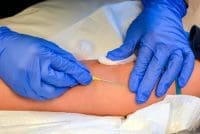Every year across the United States, qualified nursing student applicants are turned away from entering nursing programs secondary to the nursing faculty shortage, and lack of educational space such as classrooms, simulation laboratories and limited clinical practicum sites. Since 2000, the American Association of Colleges of Nursing (AACN) has been researching information about vacant nursing faculty positions by region, degree, and top issues preventing faculty recruitment and retainment. Doctor of nursing practice (DNP) nurses are qualified to offer a solution for the faculty shortage if compensated close to salaries offered in clinical practice. H. R. 728-116th Congress: Title VIII Nursing Workforce Reauthorization Act of 2019 has promise to bring the necessary funding needed for scholarships, loan forgiveness, nursing grants and faculty retention grants.
The nursing profession is an essential part of health care as the most significant sector of health care providers and educators. The faculty nursing shortage has affected the number of qualified nursing applicants by turning away approximately 75,029 students annually who are well qualified to enter baccalaureate and graduate nursing programs for the past academic year 2018-2019. In addition, other issues affecting the nursing faculty shortage include financial constraints, an aging faculty workforce with significant numbers of expected faculty retiring in the next decade. Specifically, financial constraints include faculty salary is not comparable to clinical nurses causing inequities.
State of the shortage
The average age for doctoral prepared nurse faculty is 62.4 years old; associate professors are 57.2 years old on average, with assistant professor having an average of 51.2 years and approximately 43% are doctorally prepared, mainly assistant professors.
Survey findings for the academic year 2018-2019 included:
- Full-time (FT) budgeted positions: 21,685
- FT open vacancies: 1,715 (7.9%)
- FT positions filled: 19,970 (92.1%)
- Average FT vacancies: two per school
- No FT vacancies although need additional faculty: 138 colleges
Degree requirement for the FT faculty vacancies (n = 1715) also affected those hired: doctoral (n = 962), 56.1%, master’s although doctoral preferred (n = 593) 34.6%, master’s degree (n = 149) 8.7% and other (n = 11) 0.6%. There is expense for nurses who desire doctoral degrees and the new Title VIII Nursing Workforce Reauthorization Act will be very beneficial if enacted.
The main issues associated with recruiting nursing faculty for academic year 2018-2019 were:
- Non-competitive salaries: n = 560 (64.3%) compared to clinical nurses
- Faculty with specialty mix of degree and certification: n = 549 (63%)
- Non-doctoral prepared faculty: n = 493 (56.6%)
- Limited faculty to teach clinical course: n = 235 (27.0%)
- High workload for current faculty: n = 207 (23.8%)
- Faculty willing to conduct research: n = 168 (19.8%)
Solutions to the shortage
The Title VIII Nursing Workforce Reauthorization Act is expected to assist in loan repayment programs for growing nurse faculty numbers over the next four years.
Doctoral prepared nurses are in high demand. In the past year, over 21,000 nurse faculty were needed by over 140 colleges and universities.
Strategies to make faculty positions more attractive will be to offer higher compensation in academia similar for nurses in clinical settings. Offering DNP, PhD, and Ed nursing faculty the same opportunities for tenured PhD full time associate professor faculty appointments will promote new hires, while attracting new doctoral nurses. In addition, academic promotion and tenure is essential across the board in an equitable manner to promote and retain qualified nurse faculty. Mentor programs for new hire nurse faculty members are an inclusive strategy for first year faculty success and the Nursing Workforce Reauthorization Act is well positioned to provide funding to implement this strategy.
Taking action
Solutions to reduce the nursing faculty shortage recommendations include endorsing collaborative incentives for graduate DNP nurses to choose an academic career pathway instead of a clinical career or a pathway for both academia and clinical practice. Colleges and universities should recruit qualified master’s or doctoral prepared nurse faculty and provide equitable monetary compensation for academia similar to compensation for clinical practice. Nursing mentor programs, loan repayment programs and developing equitable faculty salaries are essential for the growing demands of nursing faculty needed in academia. The Title VIII Nursing Workforce Reauthorization Act of 2019 information should be disseminated for nursing schools to take action now so the next generation of nurses are not being held back by the nursing faculty shortage and it will be a win-win!
Explore these resources:
Congress (H.R. 728-116th). Title VIII Nursing Workforce Reauthorization Act of 2019: congress.gov/bill/116th-congress/house-bill/728/committees
Health Resources & Services Administration (HRSA) grants, loans, scholarships (2019): bhw.hrsa.gov/fundingopportunities/Default.aspx?id=e7eb501a-80da-40ae-9941-964dce07b3c5
Marilyn Rodriguez is a family nurse practitioner and psychiatric mental health nurse practitioner student-doctor of nursing practice student at the University of North Florida in Jacksonville. Helene Vossos is director of the PMHNP DNP program and assistant professor of nursing at the University of North Florida in Jacksonville.
Selected references
American Association of Colleges of Nursing. Fact sheet: Nursing faculty shortage. 2019. aacnnursing.org/News-Information/Fact-sheets/Nursing-faculty-shortage
Govtrack.us. H.R. 728-116thCongress: Title VIII Nursing Workforce Reauthorization Act of 2019. govtrack.us/congress/bills/116/hr728
Haddad LM, Toney-Butler TJ. Nursing shortage. 2019. ncbi.nlm.nih.gov/books/NBK493175
RegisteredNursing.org. Is nursing education contribution to the nursing shortage? n.d. registerednursing.org/nurse-education-contributing-nursing-shortage
Tyczkowski BL, Reilly J. DNP-prepared nurse leaders: Part of the solution to the growing faculty shortage. J Nurs Adm. 2017;47(7-8):359-60.
Yan Li M, Turinetti M, Fang D. Special survey on vacant faculty positions for academic year 2018-2019. aacnnursing.org/Portals/42/News/Surveys-Data/Vacancy18.pdf



















1 Comment.
I’m sorry, but I think you missed the mark.
In 2020, I completed my MSN in Nursing Education. I worked in an ICU at the start of the pandemic. I threw my resume out there, and the initial calls came from different universities. Top income offer was roughly $60k a year. I was making much more than that in the ICU. I started applying to different health care facilities, and eventually took a salary position making $95k a year. Other facilities offered roughly $75k.
So here is the problem with the nurse faculty shortage…..
There are multiple universities where their major income is the nursing program, yet the money does not return back towards that program. Educators are underpaid, equipment is usually outdated, hours are long, and dealing with these kids is migraine inducing. There is no incentive to teach new nursing students.